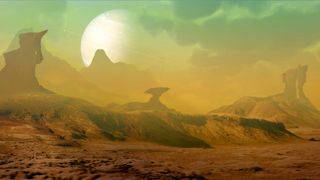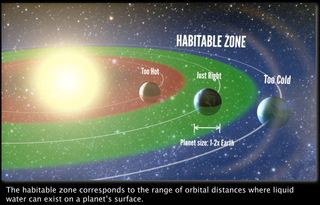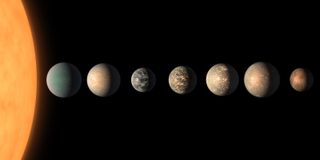The deadly atmosphere on Venus could help us find habitable worlds. Here's how
Scientists still aren't sure how Venus' environment become so out-of-control and inhospitable.

Venus has a lot to teach us, deadly as it is.
The planet Venus is often referred to as "Earth's twin" since both planetary bodies are approximately the same size and mass. But unlike Earth, which is teeming with all forms of life both large and small, the planet Venus has been observed to be far from hospitable and somewhat of a hellscape. This is due to its searing surface temperatures up to 900 degrees Fahrenheit (482 Celsius) and crushing surface pressures 90 times of the Earth.
Venus exhibits what's known as a runaway greenhouse effect, meaning solar radiation that makes it to the surface becomes trapped, increasing the pressure and temperature over time. But how did Venus' environment become so out-of-control and inhospitable, and why is it important to study the divergence between Venus and Earth? It is these questions that a team of researchers led by the University of California, Riverside (UC Riverside) hope to answer in a recent study.
Related: Venus: The scorching second planet from the sun
"Since Mars has been the center of attention in the solar system for a long time, it is usually forgotten that Venus is actually the most similar planet to Earth in terms of size and mass," Colby Ostberg, a PhD student at UC Riverside and lead author of the study, told Space.com in an email. "In addition, past works have shown that Venus could have maintained habitable surface conditions up until 1 billion years ago, which means the solar system could have had two habitable worlds in the past. Identifying what caused Venus to develop into the hellscape it is today will allow us to constrain the circumstances which lead to uninhabitable worlds. This will also be crucial for the search for life in the universe by helping identify which exoplanets should or should not be targeted in atmospheric observations with JWST or other future facilities."
For the study, the researchers examined the atmospheres of what are known as exoVenuses, which are exoplanets that lie within the Venus Zone (VZ), or inside the runaway greenhouse boundary of their parent star's orbit. Astronomers hope to use exoVenus atmospheres as analogs to not only better understand the runaway greenhouse effect of Venus, but its past, as well.
"Oxygen is often considered a potential exoplanet biosignature because, on Earth today, it is almost entirely the result of photosynthetic life," Dr. Eddie Schwieterman, who is an Assistant Professor of Astrobiology at UC Riverside and a co-author on the study, told Space.com in an email. "However, one potential abiotic way of accumulating oxygen in a planetary atmosphere is through an extended runaway greenhouse. Water is brought to the upper atmosphere and split apart by UV photons from the star, which drives the escape of the light hydrogen and retention of the heavier oxygen from that H2O.
Get the Space.com Newsletter
Breaking space news, the latest updates on rocket launches, skywatching events and more!
"There are other sinks for oxygen, but oxygen could build up in the atmosphere if they are exhausted. M dwarf stars, which are the first targets for planetary characterization with JWST, are super luminous early in their lives, and this super luminous phase would enhance the loss of atmosphere to space. We don't know how common abiotic oxygen accumulation is on exoplanets, but we would expect it to be more likely on Venus Zone planets than on planets further away from their stars. If we survey Venus Zone planets, where life is unlikely, and find many with oxygen, it may caution us regarding life interpretations on temperate planets. On the other hand, if we do not find oxygen-rich Venus Zone planets, that would be a good sign for oxygen biosignatures on Earth-like worlds inside the habitable zone."

The researchers used planetary and stellar data from the NASA Exoplanet Archive to produce a catalog of 317 confirmed terrestrial (rocky) exoplanets that orbit within the VZ, including those discovered using either transit or non-transit detection methods. They estimated the highest population of exoVenuses exist closer towards the VZ's inner boundary, but determined these candidates to not be good Venus analogs due to the loss of atmosphere they experience from their high temperatures and solar energy they receive, also known as incident flux. The researchers then calculated the potential for follow-up studies, eight of which will be observed by the James Webb Space Telescope (JWST), including GJ 357 b, GJ 1132 b, TRAPPIST-1 b, TRAPPIST-1 c, TOI-776 b, TOI-776 c, LTT 1145 A b, and L 98-59 b.
"I would say that the most important targets are those that have multiple terrestrial planets within the Venus Zone," Dr. Stephen Kane, who is a Professor of Planetary Astrophysics at UC Riverside and a co-author on the study, told Space.com in an email. "These systems allow us to carry out comparative planetology where the planets are the same age and likely have similar bulk abundances. Two examples of such systems are L 98-59 and TRAPPIST-1, both of which also allow us to investigate the effects of M dwarf activity on planetary atmosphere retention."
Read more: James Webb Space Telescope finds no atmosphere on Earth-like TRAPPIST-1 exoplanet

A vital piece for continuing this research is studying the planet Venus itself. Unfortunately, the most recent data available is from NASA's Magellan mission in the 1990s. However, the researchers mention several proposed and accepted missions to Venus, including NASA's VERITAS and DAVINCI+, the Russian Federal Space Agency's Venera-D, and the European Space Agency's EnVision.
All of these missions will provide scientists the most up-to-date data regarding Venus' atmospheric composition and structure, along with high-resolutions surface maps which could confirm recent findings that Venus is volcanically active. But these missions could also contribute to exoplanetary science, as well, by improving current climate models of exoVenuses which could help scientists predict their climates.
"Exoplanet research provides a pathway to learning about Venus and its past, but the accuracy of models used to estimate the surface conditions of Venus-like exoplanets are entirely contingent on our knowledge of the Venus here in our solar system," Ostberg told Space.com in an email. "The NASA discovery mission, VERITAS, will be going to Venus and will be an essential component to Venus and exoVenus research, and also to our understanding of the Earth. But in November 2022, its launch was delayed an additional 3 years, which will have widespread impact on a variety of fields beyond just Venusian science. It is important that the scientific community shows support for VERITAS and promotes its importance in hopes that its delay is shortened."
Unfortunately, that does not seem to be the case. In NASA's most recent budget request, funding for VERTIAS dropped from a projected $56.7 million to just $1.5 million, frustrating among its team members.
The study is described in a paper submitted in February 2023 in The Astrophysical Journal.
Follow us on Twitter @Spacedotcom and on Facebook.
Join our Space Forums to keep talking space on the latest missions, night sky and more! And if you have a news tip, correction or comment, let us know at: community@space.com.

Laurence Tognetti is a six-year USAF Veteran and science writer who earned both a BSc and MSc from the School of Earth and Space Exploration at Arizona State University. Laurence is extremely passionate about outer space and science communication, and is the author of “Outer Solar System Moons: Your Personal 3D Journey”. Follow him on Twitter and Instagram @ET_Exists.
-
rod "For the study, the researchers examined the atmospheres of what are known as exoVenuses, which are exoplanets that lie within the Venus Zone (VZ), or inside the runaway greenhouse boundary of their parent star's orbit. Astronomers hope to use exoVenus atmospheres as analogs to not only better understand the runaway greenhouse effect of Venus, but its past, as well."Reply
My notes. I read several reports recently on the VZ. Here are some examples.
Hunting Venus 2.0: Study narrows James Webb Space Telescope targets, https://phys.org/news/2023-03-venus-narrows-james-webb-space.html
ref - The Demographics of Terrestrial Planets in the Venus Zone, https://iopscience.iop.org/article/10.3847/1538-3881/acbfaf, 21-March-2023. "Abstract Understanding the physical characteristics of Venus, including its atmosphere, interior, and its evolutionary pathway with respect to Earth, remains a vital component for terrestrial planet evolution models and the emergence and/or decline of planetary habitability."
This forums discussion on Venus was interesting. NASA scientist explains why Venus is Earth's 'evil twin' (video), https://forums.space.com/threads/nasa-scientist-explains-why-venus-is-earths-evil-twin-video.59691/
GJ 3929: High Precision Photometric and Doppler Characterization of an Exo-Venus and its Hot, Mini-Neptune-mass Companion, https://arxiv.org/abs/2207.10672
Now we have some recent reports where potential smaller, rocky exoplanets show no atmospheres.
James Webb Space Telescope finds no atmosphere on Earth-like TRAPPIST-1 exoplanet, https://forums.space.com/threads/james-webb-space-telescope-finds-no-atmosphere-on-earth-like-trappist-1-exoplanet.60653/
We also have some new reports from JWST where gas giant planets like Saturn size do not follow our solar system metal content. Too much carbon relative to oxygen likely leads to planets with little or no water evolving from their postulated protoplanetary discs. https://forums.space.com/threads/webb-telescope-finds-a-hot-jupiter-exoplanet-that-defies-expectations.60679/
At the moment, with more than 5300 exoplanets documented now, Earth definitely has life on it, a fossil record, and plenty of water. Still waiting to see confirmation of a habitable exoplanet with these same properties. Rare Earth? So far, very rare Earth. -
steve_foston Perhaps 1bn years ago the Venusians were as stupid as humans appear to be today and started the runaway greenhouse effect.Reply -
rod Here is a report on Venus showing 85,000 volcanoes documented now on the planet.Reply
Scientists share 'comprehensive' map of volcanoes on Venus—all 85,000 of them, https://phys.org/news/2023-03-scientists-comprehensive-volcanoes-venusall.html
ref - A Morphological and Spatial Analysis of Volcanoes on Venus, https://agupubs.onlinelibrary.wiley.com/doi/10.1029/2023JE007753, 24-March-2023. "Abstract Venus is home to many thousands of volcanic landforms that range in size from much less than 5 km to well over 100 km in diameter. Volcanism is clearly a major, widespread process on Venus, and is a principle expression of the planet’s secular loss of interior heat. Without sufficient in situ data to clearly determine its internal structure, we can use the morphological and spatial characteristics of volcanoes across the planet to help place constraints on our understanding of the volcanic characteristics and history of Venus. With the Magellan SAR (synthetic-aperture radar) FMAP (full-resolution radar map) left- and right-look global mosaics at 75 meter-per-pixel resolution, we developed a global catalog of volcanoes on Venus that contains ∼85,000 edifices, ∼99% of which are <5 km in diameter. We find that Venus hosts far more volcanoes than previously mapped, and that although they are distributed across virtually the entire planet, size–frequency distribution analysis reveals a relative lack of edifices in the 20–100 km diameter range, which could be related to magma availability and eruption rate. Through spatial density analysis of volcanoes alongside assessments of geophysical datasets and proximal tectonic and volcanic structures, we report on the morphological and spatial patterns of volcanism on Venus to help gain new insights into the planet’s geological evolution."
I am glad I live on the very rare planet Earth. -
rod Following what I pointed out in post #4, applying to exoplanet studies for the Venus Zone (VZ), just how many are volcanically active, present or past? Venus in our solar system, the volcanic record appears now more detailed and large-scale volcanic activity could play a major role in planet wide catastrophism. I notes these exoplanets from the space.com article I mentioned directly.Reply
"The researchers then calculated the potential for follow-up studies, eight of which will be observed by the James Webb Space Telescope (JWST), including GJ 357 b, GJ 1132 b, TRAPPIST-1 b, TRAPPIST-1 c, TOI-776 b, TOI-776 c, LTT 1145 A b, and L 98-59 b. "I would say that the most important targets are those that have multiple terrestrial planets within the Venus Zone," Dr. Stephen Kane..." -
bolide Reply
1bn years ago on Earth, it was the Proterozoic Eon, during which plants formed, and the earliest animals. So it's not likely there were any Venusians then who were smart enough to be stupid.steve_foston said:Perhaps 1bn years ago the Venusians were as stupid as humans appear to be today and started the runaway greenhouse effect. -
rod Well, here is a paper that claims exoplanets do not exist. If this model is correct, astrobiology falls apart as science :)Reply
A Modest Proposal for the Non-existence of Exoplanets: The Expansion of Stellar Physics to Include Squars, https://arxiv.org/abs/2303.16915
My observation. The 7-paged PDF report attached. "5.1. Elegance Over Opulence Widespread acceptance of exoplanet detections is nothing short of a modern-day Ptolemaic fiasco. The constant addition of super
uous orbiting bodies in oder to reproduce observed data is clearly reminiscent of the historic heliocentric vs. geocentric tension. Before the adoption of the heliocentric model, epicycles were invoked to explain the motions of heavenly bodies under the preconception that the geocentric model must be an immutable truth (Ptolemy 150-170 CE). Similarly, exoplanets have been used as the great panacea of the modern age. Indeed, accepting exoplanets as established truth has enabled the rapid publishing of under-scrutinized and over-hyped scientific hypotheses that only serve to advance fame, glory, and wealth, which are so often asso-ciated with the profession of academic astronomy. But just as Galileo stood before the church, so do we stand against Big Exoplanet."
My note, the paper has a picture of a stellar squar, shaped like a square or cube. "Figure 4. While much of the stellar astrophysics community lags behind in the study of squars, advanced simulations such as Minecraft™ have already implemented squars into their universe." "5.3. Final Thoughts We have discovered a new field of astrophysics that not only simplifies our understanding of the universe but also eradicates the need for exoplanets."
Okay, no exoplanets, no abiogenesis in other areas in our galaxy :) -
murgatroyd Squars, huh? Either this paper was written in all seriousness by one of the regulars posting in this forum's Cosmology comments section, or ... (checks date) ... hmmmReply
